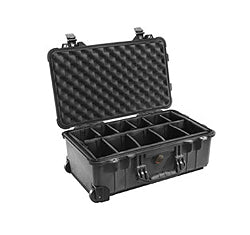Durability is one thing most photographers would appreciate more of in their equipment and equipment holders. Unfortunately, photographic and video equipment don't seem to be universally made of steel. In fact, most equipment is more than fragile, combining glass elements, sensitive electronic components, and delicate construction. One drop on a hard surface and many pieces of photographic equipment are history. Besides good insurance, it is also a reasonable idea to find some sturdy cases if you are traveling locally, nationally, or internationally with your precious cargo. Now, not all will agree with the need for an (almost) bomb-proof case, but many photographers and videographers wouldn't think of anything less than the ruggedness of the Pelican hard case. The Pelican 1510 model is effective in so many ways, and it is also FAA approved as a carry-on.
Product: Pelican 1510 Carry-on Case
Pictureline: $239.95 (with dividers) and $199.95 (with black foam insert)
CONSTRUCTION
We'll start with the obvious. The reason to buy a Pelican hardcase is for its construction. Like other models, the 1510 is watertight, airtight, rustproof, chemical resistant, and corrosion proof. The material is made of "Ultra High Impact structural copolymer." Whatever this really means can be commented on by one of the engineers. To me, this translates to: "I strapped in on the top of my river rafting cargo and ran Cataract Canyon several times with it. I can stand on it without even thinking about a problem." A neoprene O-ring does the trick of keeping it sealed. Two large ABS latches clamp it together. One addition on the Pelican cases that I enjoyed on this model was the extra metal reinforcements on the padlocks holes, giving it some extra protection when you need to lock it. In addition, this is an interesting model as it is designed with an extra extendable handle attachment, making it ideal for an airline carry-on.
PORTABILITY
Pelican cases are not necessarily the most portable containers in the world. While most of them travel very easily and securely in a vehicle or an airplane, they are not something you want to try to carry on your back for 10 miles…or even 1/10th of mile for that matter. But what they lack in comfort on the back or the hand, they make up in security and piece of mind. The 1510 model sports two heavy construction handles, one on the longside to carry it as a briefcase, and one on the shortside to carry it or more likely to drag it as a carry-on. Pelican decided to forgo the dual extender bars found on most carry-ons. The handle to drag the case on its wheels is one large sheet of material.
The wheels are equally as durable as the whole piece, and not once did I worry about the wheels breaking or coming loose. This was in stark change to previous rollerbags that tend to malfunction often around the wheels. The big question is always: "Can it fit in the overhead bin?" Oh yes. It meets the current FAA guidelines for carry-on luggage, and I actually found it smaller than most other travelers' carry-on bags. There was no problem fitting this into overhead bins, usually in either direction. (You know how current flight attendants love to ask you to stash your carry-on with rollerwheels out.) Gone are the days when I would watch like a hawk that gentleman who would start to cram his overfilled satchel and coat against my full camera gear in a soft bag. Now I just watch in amusement as people try to figure out what a sturdy looking item is doing in their overhead bin.
NEED TO CHECK?
I first took my Pelican 1510 on a long trip to Nepal, needing to carry a variety of video equipment (Canon XF300) and Canon 5D Mark II and assorted lenses. I fit into the Pelican case the following: Canon XF300 Camcorder, detached eye piece, detached hood, Rode Microphone in metal hardcase, extra microphone accessories, extra Canon battery, Canon 5D Mark II body (with no lens attached), and Canon 24 mm Tilt-Shift lens. I also had a backpack where an extra lens or two and accessories went. My fear was that I would be required to check the Pelican 1510, leaving some expensive equipment out of my reach. My solution was to carry padlocks with me, and if required, allow the TSA or other international security inspect the case while I was present and then padlock it then to be checked. Feel free to comment on how you handle your photographic equipment on airlines and especially when you fly internationally.
RANDOM SPECIFICATIONSS
Maximum Buoyancy: Floats in salt water with 64.2 lbs (29.1 kg) load
Exterior Dimensions: 22 x 13.81 x 9.0" (55.88 x 35.07 x 22.86 cm) L x W x D
Interior Dimensions: 19.75 x 11 x 7.6" (50.17 x 27.94 x 19.3 cm) L x W x D
Weight: 15 lbs 3.0 oz (6.88 kg)
BOTTOM LINE: The Pelican 1510 Carry-on is made for the photographer, videographer, or traveler who wants maximum peace of mind, despite the extra weight and boxiness that comes along with a serious hardcase carry-on.
RELATED ARTICLES
How Do I Clean My Lens?
How I Got That Shot - Royce Bair Shooting Nightscapes
Photography and eBooks: Guy Tal's Philosophy



